Over 11,000 years ago, a massive, supergiant star came to the end of its life. The star’s core collapsed to form an incredibly dense ball of neutrons, and its exterior was blasted away in an immense release of energy astronomers call a supernova.
The light from this supernova first reached Earth from the direction of the constellation Cassiopeia around 1667 A.D. If anyone alive at the time saw it, they left no records. It is likely that large amounts of dust between the dying star and Earth dimmed the brightness of the explosion to the point that it was barely, if at all, visible to the unaided eye.
The remnant of this supernova was discovered in 1947 from its powerful radio emission. Listed as Cassiopeia A, it is one of the brightest radio sources in the whole sky. More recently, the Wide-field Infrared Survey Explorer (WISE), detected infrared echoes of the flash of light rippling outwards from the supernova.
In the image, the central bright cloud of dust is the blast wave moving through interstellar space heating up dust as it goes. The blast wave travels fast – at about six percent the speed of light. By the time WISE took this image, the blast wave has expanded out to about a distance of 21 light-years from the original explosion. The flash of light from the explosion, traveling at the speed of light, has covered well over 300 light-years. The orange-colored echoes further out from the central remnant are from interstellar dust that was heated by the supernova flash centuries after the original explosion.
The colors used in this image represent specific wavelengths of infrared light. Blue and cyan (blue-green) represent light emitted predominantly from stars at wavelengths of 3.4 and 4.6 microns. Green and red represent light mostly emitted by dust at 12 and 22 microns, respectively.
NASA’s Jet Propulsion Laboratory, Pasadena, Calif., manages, and operated WISE for NASA’s Science Mission Directorate. The spacecraft was put into hibernation mode after it scanned the entire sky twice, completing its main objectives. Edward Wright is the principal investigator and is at UCLA. The mission was selected competitively under NASA’s Explorers Program managed by the agency’s Goddard Space Flight Center in Greenbelt, Md. The science instrument was built by the Space Dynamics Laboratory in Logan, Utah. The spacecraft was built by Ball Aerospace & Technologies Corp. in Boulder, Colo. Science operations and data processing take place at the Infrared Processing and Analysis Center at the California Institute of Technology in Pasadena. Caltech manages JPL for NASA.
More information is online at https://www.nasa.gov/wise, http://wise.astro.ucla.edu and http://jpl.nasa.gov/wise .
Image credit: NASA/JPL-Caltech/UCLA
3 min read





























